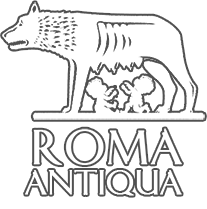Roma antica foro romano colosseo altare della patria circo massimo roma virtuale 3d lazio
percorsi5-eng
inglese



Tour 5
-from St. Peter’s Square to the rione of Parione (Piazza Navona)-
-
St. Peter’s Basilica
-
from St. Peter's Square in front of you, walk along Via della Conciliazione in the direction of Castel Sant'Angelo; now and then look left, you will notice a tall wall that runs parallel to you featuring several arched openings (in order to facilitate the local viability) as well as some battlements at the top ...... this is the PASSETTO, which had been used by the Popes to quickly and safely reach the fortified structure of CASTEL SANT’ANGELO since the Middle Ages until 1870 - the term “castle” comes from the Latin word “castrum”, which exactly refers to a fortified structure. - The castle has often been used as a papal residence during invasions, sacks and generally during periods of serious political difficulties.
-
Castel Sant' Angelo, currently a museum, is absolutely worth a visit. The upper terrace offers a comprehensive breathtaking view of the whole city.
-
now cross Ponte Sant 'Angelo, which is named after the Baroque angels (1600) that decorate the 2 balustrades: each one of them holds an object recalling the Passion of Christ. For centuries, in addition to the Milvian Bridge in the northern part of Rome and 2 ports of the Tiber Island, this bridge was the only way used by the pilgrims to reach St. Peter’s Basilica. The original bridge built here dates back approximately to 130 AD and connected the city with the Mausoleum, therefore it was called Aelian Bridge, or Bridge of Hadrian after the name of Emperor Aelius Hadrianus.
- once passed the bridge, you will face the first trident, called Piccolo Tridente (Small Trident), built in Rome at the beginning of the 16th century (the second, more renown and evident, called Grande Tridente - Big Trident -, is situated at the intersection among Piazza del Popolo, Via del Babuino, Via del Corso and Via di Ripetta). Considering the urban planning, it was essential to achieve the convergence of the roads that branched off from here up to the critical areas of the city. If you have a good map of the city, you will find it easier to understand the reasons why.
-
This small square is the starting point of 3 streets: from the right: Via Paola, Via del Banco di Santo Spirito and Via del Panìco ..... in order:
-
Via Paola, commissioned by Pope Paul III in the middle of the 16th century, which led directly to Via Giulia (the first straight road realized upon request of by Pope Julius II), in the direction of Ponte Sisto. Here leading banking families from Tuscany, as well as important religious congregations used to dwell.
-
Via del Banco di Santo Spirito which hosts the first bank in Rome, called Banca del Santo Spirito because it was founded by the Church; the street ideally goes on under the name of Via dei Banchi Vecchi, where the banks of the first money-changers used to stand, thus giving their name to the modern Banks! In short, the first bankers worked along the roads frequented by countless pilgrims heading to St. Peter's Basilica. The same street then continues under the name of Via del Pellegrino up to Campo dei Fiori.
Please, note at the beginning of the street a small arch-shaped passage called Via Arco dei Banchi, on the left corner there is a big inscription written in 1277 in vulgar Latin which indicates the level reached by the Tiber during the flood.
- Via del Panìco, after the name of the Panìco family who used to live here, the street then goes on under the name of Via dei Coronari and leads to Piazza Navona, a place that has always been used as a market.
-
Via Paola, commissioned by Pope Paul III in the middle of the 16th century, which led directly to Via Giulia (the first straight road realized upon request of by Pope Julius II), in the direction of Ponte Sisto. Here leading banking families from Tuscany, as well as important religious congregations used to dwell.
-
These were the crucial links in the Renaissance period, from the end of the 15th century until the unification of Italy (1861). In fact, the large modern streets, as well as the current expressways running parallel to the river and Corso Vittorio Emanuele II - built at the end of the 19th century, did not exist yet.
-
wandering, getting lost, walking by instinct with the curiosity of a child, strolling through the narrow streets and small alleys represent the most spectacular and romantic way to enjoy this unusual itinerary. Do not forget to look up every now and then: you will notice various decorations, the so-called “Madonnelle” on street corners, as well as turrets, flower-filled balconies, clothes hanging outside and several marble plaques commemorating a fact or a personality somehow linked to that street or building.
- The names of the streets always give us important information about the specific places. For example, some streets bear the name of the families who lived there (Via Savelli, Via Lancellotti, Piazza Farnese, Via di Monte Giordano), others the name of the jobs that was carried out or of the product that was manufactured there (Via dei sediari, Via dei baullari, Via dei Coronari, Via dei Giubbonari), other roads are named after some buildings or particular things that used to be there (Via della Quercia, Via del Fico, Via del Teatro di Pompeo, Via del Mascherone) and others remind of monasteries, convents, churches and religious congregations (Via del Montserrato, Via S. FIlippo Neri, Via S. Salvatore in Lauro) ...... and it is always along these small streets and squares that you will find the typical flavours, colours and smells of ancient Rome, as well as the shops of true craftsmen, inns, bakeries and small restaurants.
